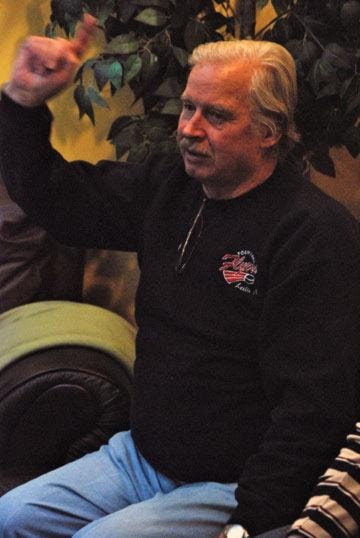In January, Rossland REAL Food’s sustainable conversation series featured Les Anderson’s fascinating tales of his childhood as the son of a game warden in the remote north of Saskatchewan.
In the previous two parts of this three-part series, we described how his family subsisted off a large garden, foraged plants, wild game, and a relationship with the native Cree population.
When the government supplied the family with horses, they had to gather hay they would scythe in a meadow about a mile and a half from the house along the river bank.
“Us kids, we used to take big sheets or an old canvas we had, and throw the cut hay onto these blankets, throw it over our back, and haul it all the way back to the house,” Anderson said.
“Every once in a while the mosquitos up north would be just rampant. You couldn’t breathe without sucking in mosquitos.”
One day, knowing about smudge pots — pails of smoking wet grass — Anderson’s brother hatched a plan to light their bundles of hay so they could get back to the house without the mosquitos bothering them.
“We didn’t realize that the hay was already getting dry. We burned everything! The hay, mom’s good sheets. We both got our butts warmed over that one!”
On wash days, they’d heat up double boilers and throw snow in. The old washing machine had been hauled in by horses in a six-day journey.
“You rocked it back and forth and us kids took turns rocking it,” Anderson recalled. “Because there was no water except for snow, you’d only change the water twice. And there were four boys by that time. So the rinse water…”
He paused. “Back then, very few people wore white because you couldn’t get them clean.”
Fabrics were a valuable resource. When wool socks wore out, for example, thumbs were added and they became mitts.
Everything from underwear and shirts to curtains were made from the patterned linen used for 100-lb. flour sacks.
“That old sewing machine we had, it had a crank at the end,” he said, “and us kids took turns cranking. If you cranked too slow, the thread would jam up. You cranked too fast, and you’d break the needle.”
“You broke the needle, you’d get the strap, because living back up in the middle of nowhere, you couldn’t get a new needle. You learned in a hurry how fast the thing had to go.”
Anderson’s father was wounded twice in Holland during the war before he was shipped home. At that time, game wardens were still under the jurisdiction of the federal government but, by 1949, jurisdiction was transferred to the provinces. Saskatchewan demanded that game wardens be educated in biology and rescue.
“When dad lost his job, there was no new job training. We were out of the government hold just like that,” he recalled. “Dad wasn’t prepared for it.”
The family moved to Love, Sask., but no houses were available and by that time there were five children in the family.
“There were a whole bunch of old wooden box cars and Dad bought two. He knocked the walls out of them, put them together, and for four years that’s where we lived.”
“Thing is,” Anderson continued, “we were equipped for that. We already knew how to grow our own food, how to survive when dad was out of work. It wasn’t as bad as people thought it was, the people in the little town. They’d bring us food baskets, but we always had lots of food. We knew how to live without a store.”
But there was always more to learn. As one example, Anderson’s dad and a Catholic priest would “make rum with a pumpkin.”
“They’d cut out the top, gouge out all the stuff inside, and pack it with coarse demerara sugar.” After sealing the pumpkin with paraffin wax, “they’d wrap it with string so it wouldn’t blow up and put it in the attic where it was fairly warm.”
Four or five months later, “you could open up the pumpkin and inside it would be like molasses. It was about 200-proof rum!” A tablespoon in tea, and you were off to the races!
Times have changed, but Anderson has tried to pass his knowledge to his children.
He remembered his daughter being embarrassed to be seen weeding in the family vegetable patch.
“Where do you think your food comes from?” Anderson asked us with a note of exasperation. “It doesn’t just appear on the store shelf in a package.”
But his love of the land worked its way into his daughter who now maintains a beautiful garden.
Today, Anderson lives in Rossland with his wife Violet.
